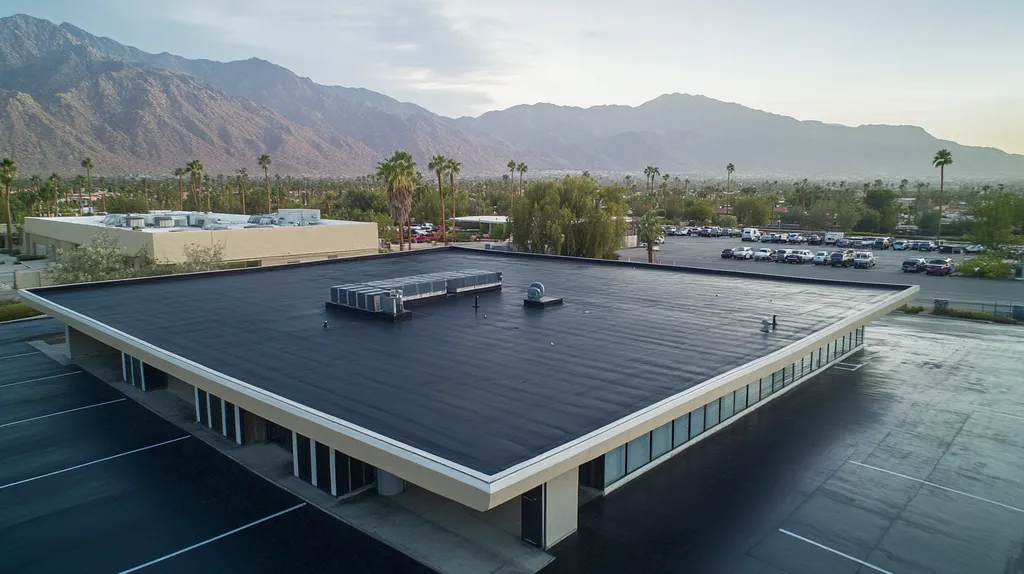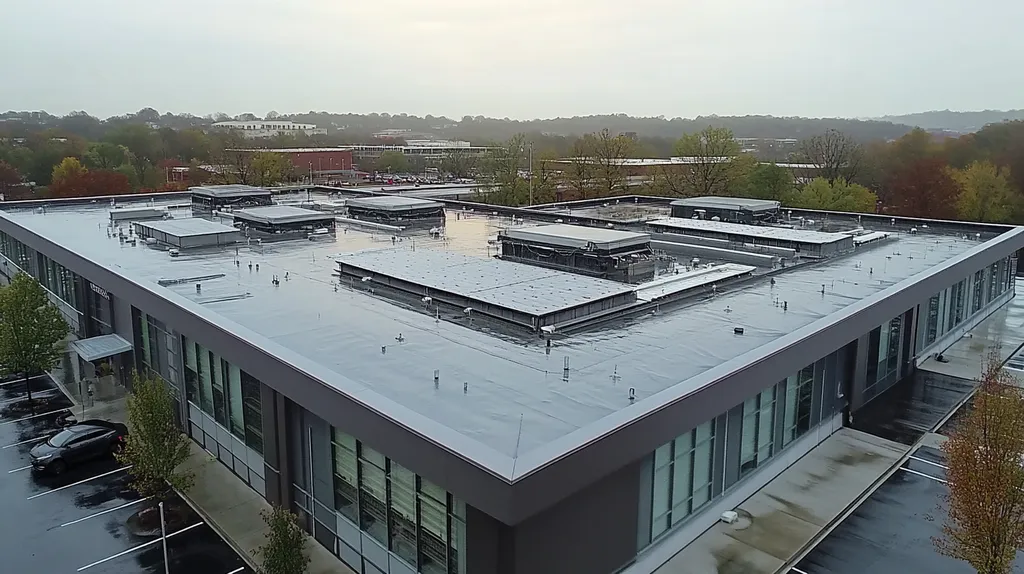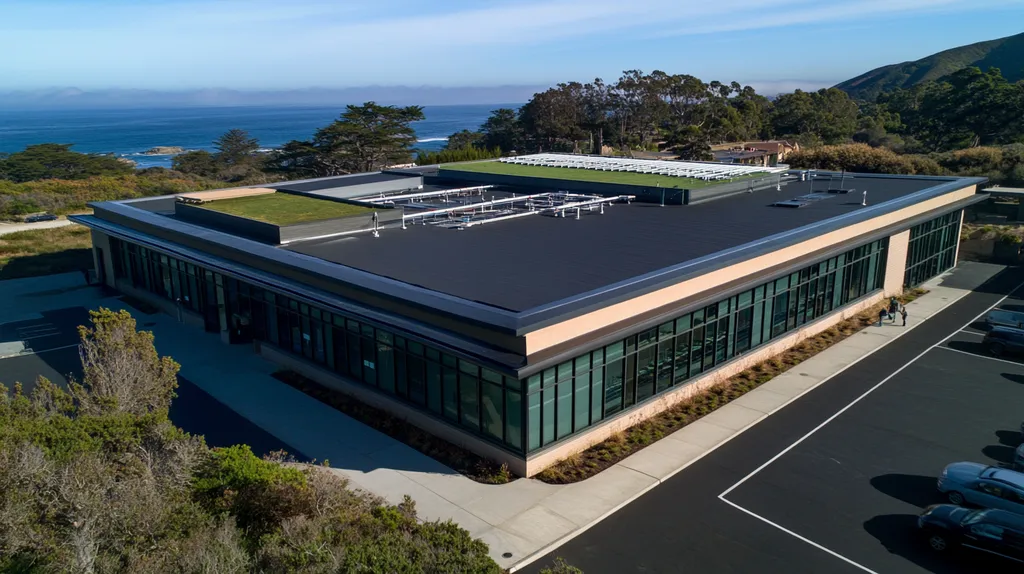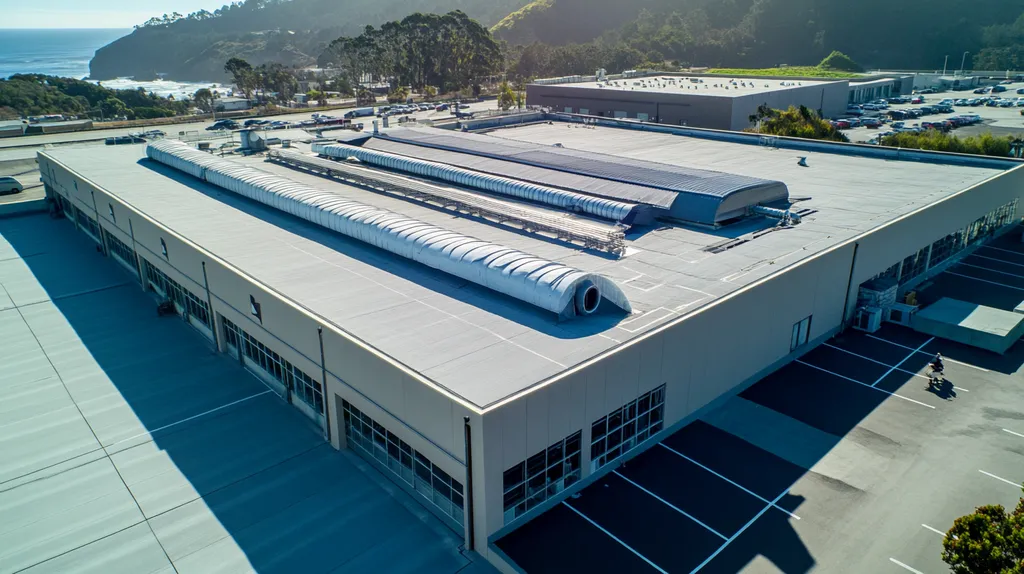In commercial roofing, crew sizing mistakes can increase project costs by up to 35% and extend timelines by weeks or even months. With the average commercial roof spanning 20,000 square feet, determining optimal workforce numbers is critical for project success.
Property owners and facility managers must navigate complex factors including material requirements, safety regulations, and specialized equipment needs when planning crew composition.
This comprehensive guide examines the essential components of crew sizing, from fundamental concepts through implementation strategies, helping decision-makers avoid costly errors while ensuring quality installations.
SECTION 1: FUNDAMENTAL CONCEPTS
In the dynamic arena of commercial roofing, selecting the right crew size can be the decisive factor between a smoothly run project and costly delays. Given that commercial roofs typically cover thousands of square feet, the implications of crew sizing are significant. An inadequately sized crew can not only inflate labor costs but can also push back timelines. By grasping the fundamental concepts of roofing, property owners and facility managers can make strategic decisions that drive project success.
Understanding Roof Size and Complexity
The dimensions and intricacies of a roof play a crucial role in determining how many workers are needed for a project. Larger roofs often require more personnel to keep operations efficient and on schedule. For instance, the dynamics of a flat roof on a warehouse differ greatly from those of a multi-pitched structure typical of a retail space.
Considerations such as roof pitch, additional features, and accessibility all contribute to the project’s complexity. Each of these factors adds varying levels of difficulty, often necessitating a more skilled crew. Complex roofs not only require more time for installation but also demand a workforce well-versed in specific techniques.
By accurately evaluating both the size and complexity of a roof, property owners can better anticipate their labor needs. Collaborating with roofing professionals to assess these elements is vital for effective crew allocation. A solid understanding of these fundamentals ensures that crews are neither underutilized nor overstaffed.
Striking the right balance in workforce numbers boosts productivity and helps meet tight deadlines—an essential aspect in commercial endeavors. Thorough preparation in analyzing roof characteristics promotes effective project management and superior outcomes.
Types of Roofing Materials and Their Implications
The selection of roofing materials is a critical factor that influences crew size and the expertise required. Various materials, including TPO, EPDM, and built-up roofs, each come with their distinct handling and installation demands. These complexities directly impact the skill set necessary for installation teams.
For instance, installing TPO roofing systems requires specific seam welding techniques, often necessitating specialized training. This expertise can limit the number of workers equipped to perform these tasks, affecting crew size. Additionally, heavier materials like tile or slate might require extra personnel to ensure proper handling and installation.
A clear understanding of the implications associated with different roofing materials assists in workforce planning. Property owners need to consider not just the quantity of workers, but also their skill levels in relation to the materials selected. Coordinating training sessions with manufacturers or suppliers can effectively enhance the team’s capabilities.
Anticipating material requirements and assembling the appropriate crew is essential for success. A well-informed approach to crew composition guarantees high-quality installations while maintaining productivity and controlling labor costs.
Labor Costs and Productivity Factors
Labor costs are a pivotal concern for any commercial roofing project. Inefficiencies arising from incorrect crew size can inflate expenses and waste resources, negatively impacting the project’s financial outcomes. Understanding key productivity factors can lead to more effective crew management.
Several factors, including weather conditions, team experience, and equipment availability, influence productivity rates. Adverse weather can slow progress, leading to a reevaluation of crew size to maintain efficiency. On the flip side, a seasoned crew may work more rapidly, potentially allowing for a streamlined workforce.
Cost considerations should also factor in indirect expenses, such as equipment rentals and tools. A lean and efficient crew can complete projects more swiftly, thereby minimizing these additional costs. Accurate labor forecasting should involve analyzing historical performance metrics to anticipate future needs.
Thoughtful planning and analysis of labor costs are vital for achieving a balance between efficiency and quality. Informed decisions regarding crew size can yield significant savings, making this an essential practice for successful project execution.
SECTION 2: SYSTEM COMPONENTS
Understanding the system components that influence crew sizing is crucial for the success of a commercial roofing project. Making poor equipment choices can lead to injuries, project delays, and soaring costs. With an estimated 30% of roofing-related accidents attributed to inadequate equipment or improper use, property owners must prioritize specialized tools, clear crew roles, and strict safety compliance to avoid significant financial and operational setbacks.
Specialized Equipment for Commercial Roofing
Specialized equipment is the backbone of successful commercial roofing projects. Tools such as skid steers, hoists, and scaffolding not only enhance efficiency but also ensure the safe transport and installation of materials. For example, using a material hoist significantly reduces manual lifting tasks, relieving strain on crew members and accelerating project timelines.
Moreover, high-quality safety gear like harnesses and guardrails protects workers from falls—a critical concern in this industry. Research shows that employing advanced safety equipment can cut fall-related injuries by over 50%. By investing in the right tools, property owners not only safeguard their workforce but also optimize workflow, leading to smoother operations.
The choice of roofing materials also affects crew size requirements. Heavier materials like tiles or slates may demand a larger crew to manage them effectively. Being informed about material specifications allows for more precise crew sizing, ensuring that projects stay on track.
Ultimately, utilizing tailored equipment designed for specific project needs is vital for effective crew sizing and productivity. Proper equipment maintains safety standards while driving project efficiency.
Crew Roles and Specializations
Clearly defined crew roles and specializations are fundamental for maximizing efficiency on a commercial roofing site. Each crew member should know their specific responsibilities, contributing to the overall success of the project. For example, roles might include roofers, installers, and safety officers, each focused on distinct tasks that ensure smooth operation.
Effectively outlining crew roles fosters better communication and reduces the risk of mistakes. A dedicated safety officer can assure compliance with safety standards, allowing skilled roofers to concentrate on their installation tasks—this teamwork enhances overall productivity.
Investing in specialized training for crew members boosts efficiency and safety. Continuous education on equipment usage and safety protocols prepares team members for potential challenges. Data indicates that firms investing in crew training can achieve a 25% increase in operational efficiency.
Implementing clearly defined roles not only aids in accurate crew sizing but also results in higher-quality work and safer job sites, benefiting both property owners and facility managers.
Safety Requirements and Compliance
Safety requirements and compliance are essential in commercial roofing, with adherence to OSHA regulations being paramount. Ignoring safety can result in severe financial penalties, not to mention reputational damage for property owners. Ensuring worker protection should never be compromised.
Conducting regular safety audits and training sessions fosters a culture of safety among the crew. Weekly safety meetings serve to keep safety at the forefront of daily operations, and evidence shows that companies with robust safety programs experience 40% fewer workplace accidents.
Equally important is ensuring compliance with safety gear standards. Workers must be equipped with helmets, harnesses, and non-slip footwear to prevent incidents. Non-compliance can cause costly project delays due to necessary inspections and remediation work.
In summary, emphasizing safety and compliance not only protects workers but also influences crew sizing positively. A safe work environment attracts skilled labor and enhances efficiency, ultimately benefiting property owners and facility managers in the long run.
SECTION 3: IMPLEMENTATION METHODS
In an industry where minor mistakes can escalate into significant delays and costs, precise crew sizing is essential. A well-defined project scope and timeline not only influence the budget but also impact the quality and safety of the final installation. Property owners must grasp the complexities of each roofing job to make informed and strategic decisions. This section outlines the vital steps for determining crew size, allocating tasks, and ultimately ensuring project success.
Assessing Project Scope and Timeline
First and foremost, a clear understanding of the roofing project’s scope is crucial. This involves evaluating the building’s size, the type of roofing material, and any specialized tasks that might be necessary. For example, a straightforward flat roof may require less attention compared to a complex multi-layered sloped design. Various factors, including weather conditions and material delivery schedules, will also affect project timelines.
Once the scope is clearly defined, property owners can better estimate how long the project is likely to take. A basic installation might be completed in a week, whereas more involved projects, like overlays or repairs, could stretch over several weeks or even months (source: GAF). Failing to accurately assess these elements can lead to scheduling conflicts and budget overruns.
Establishing milestone deadlines is also beneficial for managing expectations. By setting clear benchmarks, all stakeholders can monitor progress and adhere to timelines, thereby avoiding costly delays. A focused approach to timelines helps ensure that everyone is aligned on project goals and completion dates.
In essence, thorough assessment of the project scope and timeline lays the foundation for effective crew sizing and task management—two critical components for a successful roofing endeavor.
Determining Optimal Crew Size
Determining the optimal crew size begins with the established project scope. A larger and more complex roofing job will naturally require more hands on deck. It’s beneficial to calculate labor needs based on the square footage and the types of materials used. Generally, a standard crew can effectively cover approximately 1,500 to 2,000 square feet of roofing per day under ideal conditions.
However, individual skill sets and experience levels must also be taken into account. Highly skilled workers can perform tasks faster and more efficiently than their less experienced counterparts, influencing overall crew size requirements. By strategically incorporating skilled labor, property owners can enhance productivity without unnecessarily increasing workforce numbers.
Reviewing past project data can provide valuable insights into crew size efficiency. Analyzing historical performance on similar roofing jobs can guide property owners in deciding the right crew for their current project. This data-driven approach minimizes guesswork and enhances cost-effectiveness.
The goal is to find a balanced workforce; too few workers can lead to delays, while too many can inflate labor costs. A comprehensive assessment ensures that labor resources are utilized efficiently throughout the project, creating a streamlined and cost-effective process.
Allocating Tasks and Responsibilities
Effective task allocation is essential for maximizing crew efficiency. Each member of the crew should be assigned specific responsibilities that leverage their skillsets. Clearly defining tasks reduces confusion, improves workflow, and enhances overall productivity on the roofing site.
For instance, assigning certain team members to material handling while others concentrate on installation fosters a more efficient operation. This division of labor allows each worker to focus on their designated role, which in turn promotes a productive work environment.
Regular communication within the crew is equally important. Daily briefings can help identify potential issues and necessary adjustments in workflow. Keeping all team members informed mitigates risks and helps avoid costly mistakes.
Finally, monitoring progress and adjusting roles as needed provides flexibility in task allocation. If certain tasks are completed ahead of schedule, team members can assist their colleagues, further enhancing efficiency and maintaining project momentum. Strategic task allocation and responsibility distribution lead to successful roofing projects and satisfied property owners.
SECTION 4: MAINTENANCE REQUIREMENTS
Neglecting regular roof maintenance can result in dire consequences, including costly repairs and disruptions to business operations. In fact, statistics reveal that improper maintenance can cut a roof’s lifespan by up to 50%. Property owners and facility managers must prioritize roof upkeep, which includes regular inspections, preventive strategies, and emergency planning, to protect their investments and ensure operational stability.
Regular Inspection and Repair Needs
Conducting regular inspections is essential for catching potential problems before they escalate into major issues. It is advisable that property owners schedule professional assessments at least twice a year, ideally in the spring and fall. These inspections can identify problems such as missing shingles, clogged drains, or deterioration that could jeopardize the roof’s integrity.
During inspections, technicians also evaluate for leaks and mold, which, if detected early, can be easily addressed. Failing to acknowledge these signs can lead to escalated damage, resulting in expensive repairs down the line; a small leak can develop into severe structural harm affecting the entire building.
A robust routine repair schedule based on inspection results allows property owners to tackle minor issues promptly, thereby extending their roof’s lifespan. Additionally, regular maintenance helps ensure compliance with warranty requirements, minimizing the risk of voiding coverage.
Keeping thorough records of inspections and repairs is invaluable for long-term planning and budgeting. Understanding historical roof performance informs future decisions around repairs or replacements, enabling property owners to make strategic investments.
Preventive Maintenance Strategies
A well-formulated preventive maintenance plan is crucial for preserving a commercial roof’s integrity. Strategies such as removing debris and ensuring proper drainage can remarkably decrease the chances of damage. For example, regularly cleaning gutters and downspouts prevents water accumulation, reducing the risk of leaks and structural issues.
Applying protective coatings can further enhance the roof’s durability and reflectivity, shielding it from harmful UV rays and lowering cooling costs. Consistently sealing seams and joints helps prevent water infiltration and other common complications, preserving the roof’s overall condition.
Additionally, training facility staff to recognize warning signs empowers them to act quickly. Educating staff on when to call in professionals can significantly enhance roof protection and maintenance. An informed team allows for faster responses, addressing issues before they escalate.
Ultimately, preventive maintenance not only extends the life of the roof but also boosts energy efficiency, helping to lower utility expenses. By implementing these strategies, property owners can create a better environment for their tenants and minimize overall operational costs.
Emergency Response Planning
Developing an effective emergency response plan is vital for reducing damage during roofing emergencies. Natural disasters, such as heavy storms or snowfalls, can trigger unexpected roof failures. Having a well-documented plan enables property managers to respond swiftly and efficiently during these crises.
A critical element of the plan should include emergency contacts, such as roofing contractors and disaster recovery services. Knowing whom to contact during emergencies can significantly speed up repairs and minimize downtime, thereby lessening the impact on the business’s daily operations.
Regular reviews and updates of the emergency plan, considering changes in building structure or roofing materials, are essential. Conducting drills can prepare team members and ensure everyone understands their roles when a crisis occurs.
Moreover, discussing insurance policies alongside the emergency response plan can facilitate smoother negotiations for repairs and replacements after a storm or significant damage. An organized response leads to reduced financial impact and a quicker return to normalcy.
SECTION 5: PERFORMANCE METRICS
In the competitive world of commercial roofing, performance metrics are not just important—they’re essential. A small miscalculation in crew sizing can lead to project delays, budget overruns, and subpar quality. Alarmingly, close to 30% of roofing projects exceed their budget due to ineffective labor management. This section will explore how to effectively measure efficiency, track labor costs, and evaluate the quality of work and customer satisfaction.
Measuring Efficiency and Productivity
Efficiency plays a crucial role in both project timelines and overall costs in roofing projects. To gain meaningful insights, managers can measure performance using metrics such as square footage completed per crew member each day. Establishing these benchmarks allows for the identification of underperforming crews or inefficient work processes.
Leveraging software tools for real-time tracking can facilitate immediate adjustments. For example, if a crew falls behind schedule, additional resources can be swiftly allocated to help meet deadlines. These proactive measures help prevent costly delays and keep financial plans on track.
Additionally, regular evaluations of workforce performance create a culture of responsibility. Crews that know their productivity is being monitored tend to improve their output, ultimately enhancing the project’s profitability.
In essence, a strong focus on efficiency and productivity ensures that every square foot is effectively utilized, leading to a successful and timely project completion. By emphasizing these metrics, property owners can achieve favorable outcomes and protect their investments.
Tracking Labor Costs and Budget Compliance
Labor costs are often a significant component of the roofing budget. Accurate tracking enables property managers to maintain visibility into project expenditures, ensuring adherence to financial forecasts. Understanding hourly labor rates and total hours worked is essential for making informed decisions.
Implementing a comprehensive tracking system helps pinpoint trends in labor spending. For instance, if a particular crew consistently goes over budget on projects, it may signal a need to reevaluate their size or skill level.
Moreover, documenting labor-related costs supports better budgeting for future projects. Historical data allows managers to set realistic financial parameters, reducing the likelihood of budget overruns.
Ultimately, diligent tracking of labor costs and strict adherence to budgetary guidelines empower property owners to manage their commercial roofing projects effectively and economically.
Evaluating Job Quality and Customer Satisfaction
Quality and customer satisfaction are critical to the success of any roofing project. To gauge job quality, metrics such as callback rates, warranty claims, and customer feedback scores are valuable indicators. Evaluating a roofing job’s success hinges on how well it meets the expectations of property owners and aligns with industry standards.
Collecting customer feedback is integral to continuous improvement. Surveys and direct communications can reveal areas needing enhancement. For example, if clients frequently mention cleanup issues after installation, this becomes a key focus for future projects.
Incorporating quality checkpoints throughout the project can identify problems early, reducing rework and boosting overall satisfaction. By maintaining rigorous quality standards, roofing companies can forge stronger relationships with property owners.
In conclusion, prioritizing quality and customer feedback should be an ongoing commitment. Regular evaluation of these metrics positions companies for long-term success in the highly competitive commercial roofing landscape.
SECTION 5: PERFORMANCE METRICS
Accurate performance metrics are critical for the success of every commercial roofing project. A slight error in crew sizing can lead to significant project delays, higher costs, and compromised quality. Alarmingly, studies indicate that nearly 30% of roofing projects exceed their budget due to ineffective labor management. This section explores the essentials of measuring efficiency, tracking labor costs, and evaluating job quality to ensure project success.
Measuring Efficiency and Productivity
Efficiency is vital in the roofing industry, impacting both timelines and overall costs. Key performance metrics include the square footage completed per crew member daily. By establishing these benchmarks, managers can pinpoint underperforming crews and ineffective work processes.
Utilizing software for real-time progress tracking enables adjustments when needed. For example, if a crew is falling behind, additional personnel can be deployed to maintain deadlines. These proactive strategies help prevent costly delays and ensure financial goals are met.
Regular evaluations of crew performance create a culture of accountability. When team members are aware that their productivity is monitored, they are likely to put forth greater effort, ultimately enhancing project profitability.
By focusing on efficiency and productivity, property owners can ensure efficient use of every square foot, leading to timely project completion and protecting their investments.
Tracking Labor Costs and Budget Compliance
Labor costs are a significant component of any roofing project’s budget. Accurate tracking provides immediate visibility into whether expenditures align with financial forecasts. Property managers must have precise data on hourly labor rates and total hours worked to make informed decisions.
Implementing a comprehensive tracking system helps identify trends in labor spending. For instance, if a particular crew consistently overspends on certain projects, it may be necessary to reassess their size or skills.
Moreover, documenting labor-related expenditures supports better budgeting for future projects. Historical data enables managers to set realistic budgets, reducing the likelihood of overruns.
Diligently tracking labor costs and adhering to budgetary guidelines empower property owners to manage their roofing projects more effectively and economically.
Evaluating Job Quality and Customer Satisfaction
Quality and customer satisfaction are paramount in the roofing industry. Job quality can be measured using metrics such as callback rates, warranty claims, and customer feedback scores. The success of a roofing job largely depends on whether it meets owner expectations and industry standards.
Collecting customer feedback is essential for continuous improvement. Surveys and direct communications can highlight areas needing enhancement. For example, if clients frequently mention issues with cleanup after installations, addressing this in future projects becomes a priority.
Incorporating quality checkpoints during the project allows for early identification of issues, minimizing rework and enhancing customer satisfaction. By upholding high standards, roofing companies strengthen relationships with property owners.
Ongoing commitment to quality and customer satisfaction is crucial. Regularly evaluating these metrics positions companies for long-term success in the competitive commercial roofing market.
The Bottom Line
With commercial roofing projects averaging $250,000-500,000, proper crew sizing remains the critical factor between success and costly failure.
Research shows that incorrect crew sizing leads to 35% higher project costs and can extend timelines by 2-3 months, directly impacting a building’s operations and bottom line.
Property owners and facility managers must carefully evaluate roof complexity, material requirements, and specialized equipment needs when determining optimal crew numbers.
By implementing the strategies outlined in this guide – from precise scope assessment to performance tracking – decision-makers can avoid the common pitfalls that plague commercial roofing projects.
The stakes are simply too high to leave crew sizing to chance or gut instinct in today’s demanding commercial roofing environment.
FREQUENTLY ASKED QUESTIONS
Q. How does roof size impact crew sizing for a commercial roof?
A. The dimensions and complexity of a roof determine how many workers are required. Larger roofs necessitate more personnel to ensure efficiency and stay on schedule, while intricate designs demand skilled labor. Properly evaluating these factors allows for accurate labor needs assessment.
Q. Why is specialized equipment important for industrial roof projects?
A. Using specialized equipment significantly enhances efficiency and safety during roofing projects. Tools like hoists and scaffolding ease material transport and installation, while quality safety gear protects workers from falls. Proper equipment directly influences crew size and project success.
Q. How can property owners determine optimal crew size for commercial roofs?
A. To determine optimal crew size, property owners should assess the project scope and roofing material complexity. A larger job necessitates more workers, while skilled labor can enhance productivity without inflating workforce numbers. Using historical performance data can guide these decisions effectively.
Q. What regular maintenance is needed for a commercial roof?
A. Regular inspections at least twice a year are crucial to catch potential issues early. These should include checking for leaks, clogged drains, and other signs of wear. A proactive maintenance plan helps extend roof lifespan and maintains its integrity over time.
Q. How can performance metrics influence crew sizing for commercial roofing?
A. Performance metrics such as square footage completed help identify underperforming crews and improve efficiency. Regular evaluations foster accountability which enhances productivity. Tracking these metrics ensures that labor resources are utilized effectively, leading to timely project completion and budget adherence.
Q. How can weather conditions affect crew sizing for an industrial roof?
A. Weather conditions can dramatically impact project timelines and crew productivity. Adverse weather may slow progress, necessitating reevaluation of crew size to maintain efficiency. Seasoned crews may mitigate delays, while insufficient workers can exacerbate project timelines further.
Q. What are the implications of not providing proper training for crews on a commercial roof?
A. Inadequately trained crews risk safety violations and poor workmanship, leading to project delays and safety incidents. Increased rework from mistakes can inflate costs and delay timelines. Investing in training is essential for maintaining high-quality standards and ensuring workforce safety.











